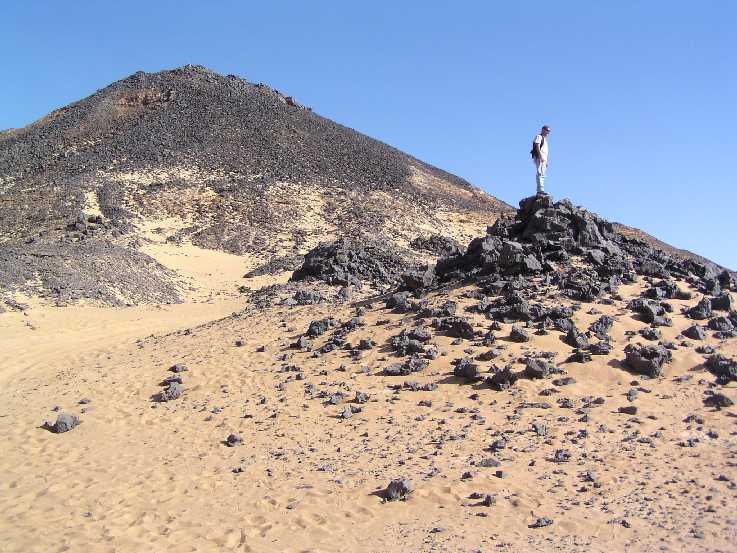The Black Desert
The area around Bahariya was volcanic and is called the Black Desert for the shards, large and small, of basalt that litter the ground. Tamer stands on the outcrop.
The White Desert
As we travelled toward the oasis of Farafra, we came to an area of chalk and limestone that is called the White Desert.
The wind has sculpted the rock into the most surreal shapes.
Although the stuff in the foreground looks like snow, it is solid sheets of rock, not even drifts of small stones.
As the sun went down, the colours changed to the most beautiful hues.
We stayed until the sun had gone below the horizon.
Car Stuck in Sand
Our car, as was not uncommon, got stuck when we stopped even though the tires were slightly deflated for the sand. All the drivers piled out to push and it never took too long before we were zipping along. The cars carried all sorts of emergency equipment and parts, and even if one car had broken down unrepairably, we had an extra car so a couple of drivers could stay with the disabled vehicle while the rest of us continued on to the next place from which help could be sent back. However, that never happened.
Farafra hotel entrance
Our hotel at Farafra was lovely, with a pool fed by a 'hot' (warm, anyway) spring, and barrel-vaulted rooms. Barrel-vaulting is common where wood for horizontal roof beams is scarce, and it also works well to keep the room cool.
Farafra Artist's studio
In Farafra, we visited an artist's studio. I was not clear as to whether it was all one man's work, but the whole place was delightfully eccentric, with even the walls carved.
Sculpture
The artist clearly had a sense of humour.
Great Sand Sea
On our way to the next oasis, Dakhla, we went off-road onto the Great Sand Sea again, but here it was perfectly flat. A mirage shows beneath the car.
Tire Jack for Use in Sand
When we stopped, one car had to change a flat tire. Even though the sand was relatively firm, the tire-jack could not be used and several men held the car up instead.
Dakhla
Dakhla, like Siwa, has an old mud-brick area, but here it is in better shape and is called al-Qasr. The minaret visible is from the 12th Century.
Market
We had lunch near this market stall, where boys demanding pens besieged us. Even some of the guards at sites in the oases would ask for pens rather than baksheesh (tips).
Al Qasr House
The al-Qasr section is protected as a heritage area and no new construction is allowed, but some people still live in it.
Al Qasr Courtroom
I don't know the date of this courtroom, but it was quite impressive, with shelves all around the walls, and just visible to the left, an alcove where the judge would have sat. Outside was a beam from which transgressors sentenced to death were hung.
Dakhla hotel
At first I thought this was another heritage site, but it turns out it was a lovely new hotel where we stayed. The rooms were in 2-storey small buildings, arranged something like a little village.
Dakhla View
The view from the hotel was gorgeous; the hills looked unreal, as if they were a watercolour painting. Click on the picture to enlarge.

